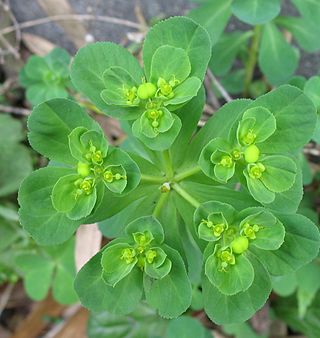Euphorbia helioscopia
Species of flowering plant From Wikipedia, the free encyclopedia
Euphorbia helioscopia, the sun spurge or madwoman's milk,[1] is a species of flowering plant in the spurge family Euphorbiaceae. It is a herbaceous annual plant, native to most of Europe, northern Africa, and eastward through most of Asia.[2][3][4]
| Euphorbia helioscopia | |
|---|---|
 | |
| Flowers and immature fruit | |
| Scientific classification | |
| Kingdom: | Plantae |
| Clade: | Tracheophytes |
| Clade: | Angiosperms |
| Clade: | Eudicots |
| Clade: | Rosids |
| Order: | Malpighiales |
| Family: | Euphorbiaceae |
| Genus: | Euphorbia |
| Species: | E. helioscopia |
| Binomial name | |
| Euphorbia helioscopia | |
Additional folk names include wart spurge, summer spurge, umbrella milkweed, and wolf's-milk. [5][6]
Description
Euphorbia helioscopia is an annual plant growing in arable land and disturbed ground. It grows to 10–50 cm tall, with a single, erect, hairless stem, branching toward the top. The leaves are oval, broadest near the tip, 1.5–3 cm long, with a finely toothed margin. The flowers are small, yellow-green, with two to five basal bracts similar to the leaves but yellower. Flowering lasts from mid-spring to late summer.[4][5]
Similar species include Euphorbia rhabdotosperma, having the appearance of E. helioscopia with smaller parts and differing seed surface [7] (Iran, North Caucasus, Transcaucasus, Turkey, Turkmenistan).
Uses
Active ingredients extracted from Euphorbia helioscopia are used in pharmaceutical industry.[citation needed] The plant is used in Chinese traditional medicine.[8]
Its extract has been found to inhibit hepatocellular carcinoma in vivo in mice.[9]
Chemistry
Euphorbia helioscopia contains toxic diterpenes[10] and diterpenoids[11] and phorbol esters. These substances are the major skin irritants found in the plant.[12] The plant is considered poisonous when eaten raw. Nausea, allergic reactions, skin irritation, vomiting may occur after eating. [13]
A number of tannins can be found in E. helioscopia.[14] Helioscopinin-A shows anti-allergic and anti-asthmatic activities in guinea pigs. It is suggested that this compound exerts its activities through antagonism on leukotriene D4-induced responses.[15]
References
Wikiwand - on
Seamless Wikipedia browsing. On steroids.
